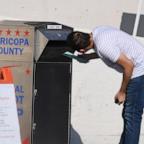Chaos and Crime: The Trials of Running a Syrian Refugee Camp
Local mafia controls a Jordanian camp housing over 100,000 war refugees.
June 30, 2013— -- Local mafia controls a Jordanian camp housing over 100,000 war refugees from Syria. A German aid worker competing with these criminals is determined to preserve the camp residents' dignity.
Kilian Kleinschmidt walks into the camp armed with a 6-inch stainless steel hook. "I hate refugee camps," he says. He is holding the hook in his hand like a dagger.
It is getting dark, and a military policeman tells Kleinschmidt that under no circumstances should he go into the camp at night. Kleinschmidt walks through the gate in silence.
The Zaatari Camp houses 116,000 refugees who fled to Jordan from the war in Syria. They live in trailers and tents with the letters UNHCR imprinted on them in blue. The UNHCR, or United Nations High Commissioner for Refugees, is Kleinschmidt's employer. The refugees arrive in buses from the border in this stretch of desert in northern Jordan, and their numbers are growing by the day. The local Bedouins say that before the refugees came, the only resident of this desert was the devil. Not even scorpions lived there.
Kleinschmidt's job is to ensure that the refugees survive in the Zaatari Camp. He wants to give them back their dignity, and he is supposed to create order in the camp. Kleinschmidt is German. A German can restore order -- at least that's the gist of the plan.
The refugees receive water, food, shelter, toilets and warm blankets for the night. They could be satisfied. Instead, they stormed a trailer where detergent was being distributed, and broke an aid worker's foot with a rock. Kleinschmidt was caught in the middle of a battle between the military police and refugees, and his throat still hurts from the tear gas. Refugees also pulled a police officer from his obstacle-clearing tank and beat him on the head with a rock.
Every day, four buses stop at the camp to collect people who want to travel back to Syria. The refugees stand in line in the morning, and when the buses arrive, they fight over seats, because they would rather live in a war zone than in Zaatari. For Kleinschmidt, the camp is a place where the devil still lives today.
A Parade of Aid Organizations
In March, the UNHCR assigned him to rescue Zaatari from chaos. He was flown in from Kenya, put in a trailer in an area secured with fences, barbed wire and guards, and given a stack of business cards that read "Senior Field Coordinator," indicating that he was in charge at the camp.
Kleinschmidt spent 10 days touring the premises. Speaking to the people there, he determined that the aid workers had managed to save the lives of all the refugees and satisfy their basic needs, but no one had been able to make the refugees happy. Kleinschmidt thought about it and concluded that Zaatari must have two problems. The first is the refugees, and the second is the aid workers.
Before Kleinschmidt embarked on his nighttime walk, he passed through the camp where a number of aid organizations are located. He walked by the trailers housing the offices of: UNICEF, UNHCR, the German Federal Agency for Technical Relief (THW), the International Medical Corps, Mercy Corps, Save the Children, International Relief & Development, the World Food Programme, the Norwegian Refugee Council, the United Nations Population Fund, the Noor Al Hussein Foundation, the Jordan Health Aid Society, Oxfam, the International Rescue Committee, Relief International, Reach, Japan Emergency NGO, and the Japan International Cooperation Agency.




